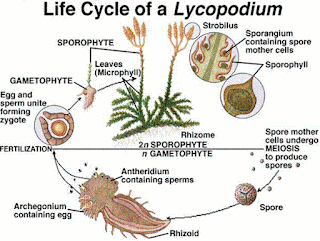Pteridophtes
Before the flowering plants, the landscape was dominated with plants that looked like ferns for hundreds of millions of years. Pteridophytes show many characteristics of their ancestors. Unlike most other members of the Plant Kingdom, pteridophytes don’t reproduce through seeds, they reproduce through spores instead seed.
Pteridophyta Classification
Pteridophyta is classified into four main classes:
Psilopsida
- They are the most primitive.
- The stem is photosynthetic and dichotomously branched.
- Rhizoids are present.
- Leaves are mostly absent.
- The sporophyte is homosporous synangium.
- Examples- Psilotum and Tmesipteris.
Lycopsida
- They are commonly known as club moss.
- Well-differentiated plant body with adventitious root, stem, rhizophores and leaves.
- The sporophyte is homosporous or heterosporous.
- Examples- Selaginella, Lycopodium.
Sphenopsida
- Commonly known as horsetail.
- Well-differentiated plant body with roots arising from nodes of the underground rhizome, stem and scaly leaves.
- Homosporous, sporangia are borne on strobili.
- Examples- Equisetum.
Pteropsida
- Commonly known as a fern.
- Well-differentiated plant body with roots, stem and leaves.
- The sporophyte is homosporous or heterosporous.
- Antherozoids are multiflagellate.
- Examples- Pteris, Dryopteris, Adiantum
Pteridophyta Characteristics
1. Pteridophytes are considered as the first plants to be evolved on land:
It is speculated that life began in the oceans, and through millions of years of evolution, life slowly adapted on to dry land. And among the first of the plants to truly live on land were the Pteridophytes.
2. They are cryptogams, seedless and vascular:
Pteridophytes are seedless, and they reproduce through spores. They contain vascular tissues but lack xylem vessels and phloem companion cells.
3. The plant body has true roots, stem and leaves:
They have well-differentiated plant body into root, stem and leaves.
4. Spores develop in sporangia:
The sporangium is the structures in which spores are formed. They are usually homosporous (meaning: one type of spore is produced) and are also heterosporous, (meaning: two kinds of spores are produced.)
Read More: Sporulation
5. Sporangia are produced in groups on sporophylls:
Leaves that bear the sporangia are termed as sporophylls. The tip of the leaves tends to curl inwards to protect the vulnerable growing parts.
6. Sex organs are multicellular:
The male sex organs are called antheridia, while the female sex organs are called archegonia.
7. They show true alternation of generations:
The sporophyte generation and the gametophyte generation are observed in Pteridophytes. The diploid sporophyte is the main plant body.
Life Cycle of Pteridophyta
Pteridophytes show alternation of generations. Their life cycle is similar to seed-bearing plants, however, the pteridophytes differ from mosses and seed plants as both haploid gametophyte and diploid sporophyte generations are independent and free-living. The sexuality of pteridophytic gametophytes can be classified as follows:
- Dioicous: the individual gametophyte is either a male producing antheridia and sperm or a female producing archegonia and egg cells.
- Monoicous: every individual gametophyte may produce both antheridia and archegonia and it can function both as a male as well as a female.
- Protandrous: the antheridia matures before the archegonia.
- Protogynous: the archegonia matures before the antheridia.
Pteridophyta Examples
Following are the important examples of Pteridophyta:
- Whisk Fern
- Dicksonia
- Selaginella
- Lycopodium
- Equisetum
- Pteris
- Dryopteris
- Adiantum
- Man fern
- Silver fern
Conclusion
Pteridophyta is one of the older groups of plants present in the Plant kingdom. They have evolved much earlier than the angiosperms. They are one of the very first “true” plants to adapt to life on land.
Primary characteristics of Pteridophytes are as follows: They are seedless, vascular plants that show true alternation of generations. Furthermore, the sporophyte has true roots, stems and leaves. They reproduce by spores, which are developed in sporangia. They may be homosporous or heterosporous.






Comments
Post a Comment